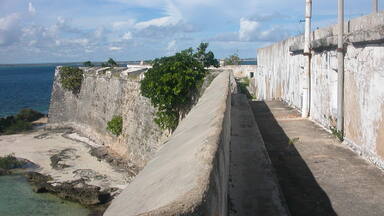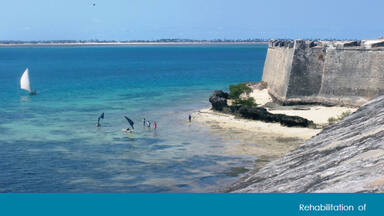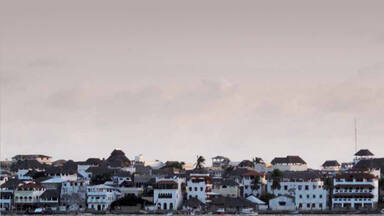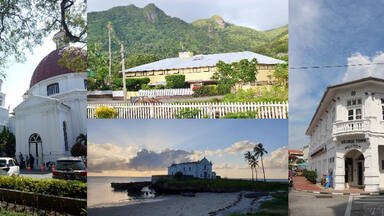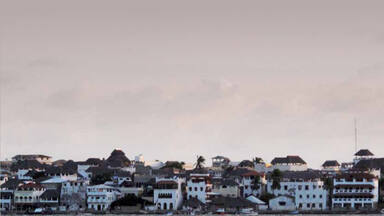Island of Mozambique
Island of Mozambique
The fortified city of Mozambique is located on this island, a former Portuguese trading-post on the route to India. Its remarkable architectural unity is due to the consistent use, since the 16th century, of the same building techniques, building materials (stone or macuti) and decorative principles.
Description is available under license CC-BY-SA IGO 3.0
Île de Mozambique
La ville fortifiée de Mozambique est située sur cette île, qui était un ancien comptoir portugais sur la route des Indes. Son étonnante unité architecturale est due à l'utilisation constante, depuis le XVIe siècle, des mêmes techniques et matériaux (pierre ou macuti) et des mêmes principes décoratifs.
Description is available under license CC-BY-SA IGO 3.0
جزيرة الموزمبيق
تقع مدينة الموزمبيق المحصّنة على هذه الجزيرة التي كانت تُعتبر بمثابة متجر برتغالي قديم على طريق الهند. وتعود وحدتها الهندسيّة المدهشة إلى الاستعمال المستمر للتقنيات والمواد ذاتها (الحجارة والماكوتي) والمبادئ التزيينيّة نفسها منذ القرن السادس عشر.
source: UNESCO/CPE
Description is available under license CC-BY-SA IGO 3.0
莫桑比克岛
坚不可摧的莫桑比克城就建在这个岛上,它是历史上葡萄牙人前往印度途中的一个贸易口岸。自16世纪以来,由于城镇建设自始至终使用相同的建筑技术、采用相同的建筑材料以及遵循相同的装饰原则,使得整个城镇的建筑风格保持着惊人的一致性。
source: UNESCO/CPE
Description is available under license CC-BY-SA IGO 3.0
Город-остров Мозамбик
Укрепленный город Мозамбик, расположенный на одноименном острове, – это бывший португальский торговый форпост на пути в Индию. Его замечательная архитектурная целостность обусловлена последовательным использованием, начиная с XVI в., одних и тех же методов строительства, строительных материалов (камень «макути») и приемов украшения фасадов.
source: UNESCO/CPE
Description is available under license CC-BY-SA IGO 3.0
Isla de Mozambique
En esta isla se halla la ciudad fortificada de Mozambique, antigua factoría portuguesa situada en la ruta marítima de la India. Su sorprendente unidad arquitectónica se debe a la una utilización constante de los mismos métodos de construcción y materiales (piedra o macuti) desde el siglo XVI, así como la aplicación de principios ornamentales siempre idénticos.
source: UNESCO/CPE
Description is available under license CC-BY-SA IGO 3.0
モザンビーク島
source: NFUAJ
Eiland Mozambique
Op het eiland Mozambique ligt de versterkte stad Mozambique, een voormalige Portugese handelspost op de route naar India. Zijn opmerkelijke architecturale eenheid is te danken aan het – sinds de 16e eeuw – consequente gebruik van dezelfde bouwtechnieken, bouwmaterialen (steen of ‘macuti’) en decoratieve principes. Het grondgebied van Mozambique werd bewoond door een Bantu stam en rond het jaar 900 door de Arabieren bezet. Vasco da Gama heeft het eiland veroverd terwijl hij op zoek was naar een route over zee naar India. De haven van Mozambique was een van de belangrijkste havens en handelsposten van Portugal op de zeeroute naar India.
Source: unesco.nl
Outstanding Universal Value
Brief Synthesis
The Island of Mozambique is a calcareous coral reef situated 4 km from the mainland coast in the entrance to the Mossuril Bay of the Indian Ocean in Nampula Province of the Republic of Mozambique. A bridge built in the 1960s joins the island to the mainland. The island forms an archipelago with two small uninhabited islands, the Islands of Goa and Sena to the east.
The island communities are intimately associated with the history of navigation in the Indian Ocean as the island played a unique role in intercontinental trading links from the 10th century. Its international historic importance relates to the development and establishment of Portuguese maritime routes between Western Europe and the Indian subcontinent.
The Island of Mozambique has two different types of dwellings and urban systems. The stone and lime town of Swahili, Arab and European influences in the north half, and the macuti town (city of roofed palm leaves) of traditional African architecture in the south. The stone and lime town, with its administrative and commercial properties, was the first seat of the Portuguese colonial government that lasted from 1507 to 1898. Thereafter the capital was transferred to Lourenço Marques now Maputo.The urban fabric and fortifications of Mozambique Island are exceptional examples of architecture and building techniques resulting from cultural diversity, and the interaction of people of Bantu, Swahili, Arab, Persian, Indian and European origin.
The incredible architectural unity of the island derives from the uninterrupted use of the same building techniques with the same materials and the same decorative principles. The island’s patrimony also includes its oldest extant fortress (St. Sebastian, 1558-1620), other defensive buildings and numerous religious buildings (including many from the 16th century).
Criterion (iv): The town and the fortifications on the Island of Mozambique are an outstanding example of an architecture in which local traditions, Portuguese influences and, to a somewhat lesser extent, Indian and Arab influences are all interwoven.
Criterion (vi): The Island of Mozambique bears important witness to the establishment and development of the Portuguese maritime routes between Western Europe and the Indian sub-continent and thence all of Asia.
Integrity
The boundaries encompass the whole of the Island of Mozambique. The other two islands of the archipelago are in the buffer zone. The boundary includes all the key attributes of outstanding universal value. However the setting of the island is vulnerable and the buffer zone needs to be extended.
The important architectural attributes and masonry building techniques of the unused fortress, and the defensive, religious and administrative buildings remain in the stone and lime town although all require restoration. Many historic buildings are in a state of advanced decay with some in ruins.
In macuti town an enormous population influx that occurred during the 16 years war (1976-1992), has led to overcrowding and poverty, water supply and sanitation problems, erosion and the serious decay of buildings, the technical infrastructure and built environment. In the macuti town the scarcity and elevated costs of building materials have not been conducive to carrying out maintenance or improvements.
The state of conservation of the architectural heritage was not fully satisfactory at the time of the ICOMOS evaluation. In 2011 the conditions were even worse due to extreme population pressures. The integrity of the main island is highly vulnerable.
The island is also in the path of cyclones and much remedial work to the damaged buildings has been required as a result of the devastating 1994 storm.
Authenticity
The existing houses and structures on the island provide evidence that the building materials and techniques are original. The majority of buildings that had administrative, commercial and military functions are still in the same general form and design of their period of construction but the conservation of a living monument, inter-twined with difficult socio-economic problems and changing demands on the urban fabric, requires a particularly sensitive approach.
Building upon and enhancing the remaining authentic nature of the property, a comprehensive study entitled ‘An Agenda for Sustainable Human Development and Integral Conservation”, with relevant recommendations that fully recognised the islands’ remaining authenticity, was prepared following a detailed mission in 1996.
However, the traditional residences have changed in form and design in consequence of the different influences and evolving social and economic circumstances affecting the island. If the present development trends are not reversed, and its transformation through the use of modern building materials continues, there is a real possibility that the authenticity of the macuti town could be compromised. The overall authenticity of the property is highly vulnerable.
Protection and Management requirements
Since 1878 local by-laws have restricted changes to the urban environment and, in principle, these are still valid. The list of Classified Historical Monuments drawn up by the former colonial Commission for Monuments and Historic Relics in Mozambique in 1943, and subsequent years, is presently being adjusted according to new criteria under the national Monument policy.
The Law for the Protection of the Mozambican Cultural Patrimony (Law No. 10/88) determines that the entire old town is explicitly classified as a urban ensemble , and that all buildings older than 1920 are classified as national cultural patrimony to be registered in the National Register for Cultural Heritage within the Ministry for Culture. Under that Law it is also defined duty of any holder of classified cultural patrimony to secure and maintain the property.
Since independence in 1975, the Mozambican Constitution stipulated building ownership whereby the conditions of use and profit are governed by the State. In 1976 all buildings for rent were nationalised and the Administração do Parque Imobiliário do Estado (APIE) (“State Housing Stock Administration”) was established as being responsible for rent collection - of which 30% was intended to cover the APIE administration and building maintenance. However, this measure did not result given the overall challenges to be faced.
In 1975 the National Service of Museums and Antiquities was organised and, in 1977, a Brigade for the Conservation and Restoration of Ilha de Moçambique was established, followed by an Office for the Conservation and Restoration of Monuments in 1980. A cooperation programme began with Nordic countries in 1983 but this only lasted two years, due to the insecurity created by war situation.
The Law for the Protection of the Cultural heritage of Mozambique was passed in 1988 and declared automatically the whole island, as a national cultural heritage. The Ministry of Culture was formally identified as being responsible for the protection of the cultural heritage through the National Directorate for Cultural Heritage but this unit was abolished by 1996. However, the two Departments of Museums and Monuments continued to coordinate activities in the island.
In consequence of the detailed 1996 mission report findings in the "Programme for Sustainable Human Development and Integral Conservation", a jointly funded two-year international programme initiated a number of micro-projects in water and sanitation, tourism development, and heritage restoration.
Subsequent reporting missions in 2000, 2003, 2005, 2006, 2007, and especially that of 2010, revealed some positive progress had been made, including the setting up of a new Ministry for Culture with the re-establishment of the National Directorate for Cultural Heritage, and the tightening up of development controls. Echoing the other findings, the 2010 mission observed that much still remained to be done, particularly with regard to coordinating conservation works and training; halting the collapse of buildings; addressing the water supply and sewage disposal problems; the implementation of an emergency action plan; the provision of a responsible authority; the delineation of a buffer zone; and progress against previous mission findings.
In addition, in 2006 the Government approved a Special status for the island and created a Conservation Office that is now established, but in need of more specialized staff.
A management plan for the World Heritage property was finalized and approved by the Government of Mozambique in 2010, with support from different international partners, including UNESCO, African World Heritage Fund, and the Africa 2009 Programme. The plan will ensure the protection of both tangible and intangible aspects of the property and its buffer zone, through the formal recognition of traditional protection systems that have been in existence for decades, and other measures. A Technical Commission was also established for the island. A cooperation Programme with the World Heritage Centre is looking at how the management system might benefit from ideas within the Urban
Historical Landscape initiative and is also helping to delineate a buffer zone which needs to be submitted to the World Heritage Committee for approval.
The property is at a critical stage and there is a need to bring in multi-disciplinary expertise to assist in supporting a major initiative to foster sustainable development in the light of massive problems of over-crowding and threats to the built fabric and urban spaces (Declaração submetida ao ICOMOS).
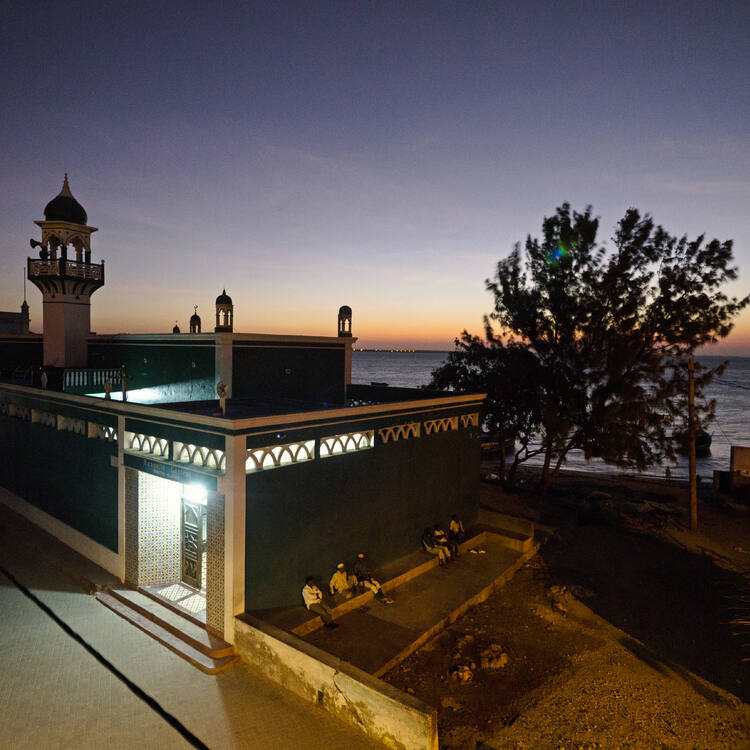
 View photos from OUR PLACE the World Heritage collection
View photos from OUR PLACE the World Heritage collection

